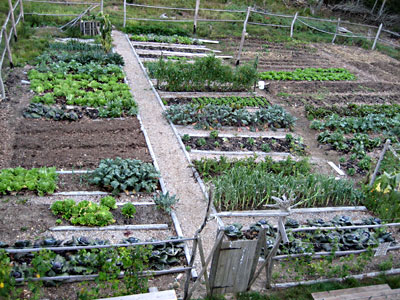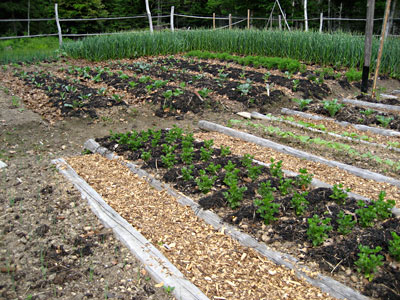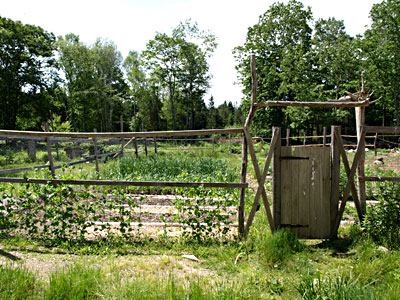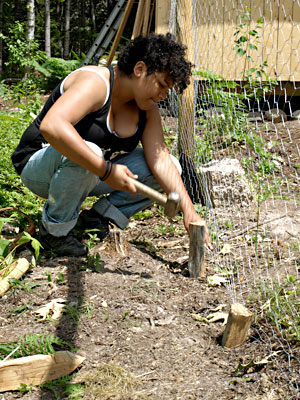 |
| The gardens at the Deer Isle Hostel are designed in a simple, straight-row layout and consist of four areas: raised beds lined with logs, open areas, beds along the fence and paths. Photo by Anneli Carter-Sundqvist. |
 |
| Permanent paths between the raised beds are mulched with wood chips and in the open areas with leaves that will break down and can be mixed with the soil next season. Mulching is the most important preventive task to minimize weed pressure. Photo by Anneli Carter-Sundqvist. |
 |
| The 6-foot fence is part function, part aesthetics. The posts are made from oak and locust and the railing from spruce. The chicken wire is nearly transparent and blends into the landscape, and the height keeps the deer out. Photo by Katja Evasdotter. |
By Anneli Carter-Sundqvist
Our organic gardens are the hub of our homestead. They serve many functions, such as increasing our self-reliance and food security, adding to the beauty of our farm, fostering our health, providing teaching opportunities, adding to the uniqueness of our lodging business and enabling our very limited need of money.
When my husband, Dennis Carter, first came here 15 years ago, the driveway went straight through what is now one of our gardens. Until a few years ago, our other garden area was still a forest floor with standing trees. Today our two gardens together measure about 8,000 square feet and provide us with food year round, as well as plenty to trade and give away.
A Natural and Economical Philosophy
The overarching philosophy for our gardens and for our homestead is that they should be maintained and enhanced as much as possible using local, free and natural materials, and that aesthetics and practical functionality are inseparable. Everything around our farm should please the eye, which for us usually means being made from wood, glass or stone and having a designated location and a form and color that blend into a natural landscape.
To be fully satisfactory, the garden should also “work well” – adding to the ease with which we carry out our chores, saving time, being low-maintenance and durable, and benefiting the health of our land and ourselves.
Our garden design is a simple, straight-row layout that is symmetrical and harmonious and also efficient to work in with wheel barrows and hand tools, such as a broad fork, rake and slicing hoe. We maximize yield by building the soil with natural materials, incorporating succession planting and using space intensively. We minimize the work by preventing weeds, managing moisture (to avoid watering) and timing our actions with the weather and seasons so that sun, rain, heat and cool work in our favor.
We don’t have a greenhouse or use row covers or plastic mulches in our garden, since they don’t meet our aesthetic ideals. Instead we achieve a longer growing season by using cold frames made from wood and recycled glass to overwinter greens and to start brassica seedlings.
Multipurpose Fence
Our garden fence is one example of blending form and function. Deer are the greatest pest threat to our gardens, and our 6-foot-tall chicken wire fence combined with the garden’s close proximity to our house keeps them out. It’s sturdy, yet the wire is thin enough to make the fence nearly transparent. The wooden posts and railings blend with the homestead picture, and for maintenance we spend only a couple of days each year replacing parts broken by wear or the weight of snow.
We prefer to use black locust wood as fence posts, since it’s likely to last for decades without rotting. It grows on the island and nearby on the mainland, and we’re often contacted to salvage parts of trees that people need to cut down. Red oak is a compromise in quality, but it grows on our land, making it a sustainable option when we need it. If the part that will be buried in the ground as well as some 8 inches above that line is thoroughly charred, it can last up to 10 years. Charring is done by placing the lower part of the post over an open camp fire and slowly turning it. The outside of the post will turn into charcoal and the interior heartwood will, through the heating process, become more rot resistant.
We dig post holes 30 to 32 inches deep to get below the frost line and to prevent posts from heaving in spring, and we backfill with rocks to secure the posts. Does this sound like a lot of work? Trust me, it is. But a fence post of the right material, properly set in the ground, will be there for decades and over time will amount to less work (and headache) than having to redo it in five or six years.
 |
| Summer helper Jennifer Cronbom attaches the fence to the ground with heavy wooden pegs. Katja Evasdotter photo. |
We attach the chicken wire to horizontal railings run at heights of 3 and 6 feet. The fence is made taut and fastened to the ground using wooden pegs with a diagonal nail that hooks onto the wire. The railings are made from dense, slow growing red spruce that we harvest from our land. The best way to increase the longevity of the railings is to peel off about half the bark in strips so that the wood can dry slowly and cracks will be minimal, preventing water from seeping in and rotting the wood. We situate gates so that the gardens are accessible from several directions, which makes it both more inviting to enter and easier to work in.
Four Types of Garden Areas
The gardens are roughly divided into four kinds of areas, each for a particular use. We have raised beds, open areas, beds along the fence, and paths.
We frame raised beds with logs, usually spruce or fir. They are 16 feet long and lay about 3 to 4 inches higher than ground level. The beds are roughly 32 inches wide, not including the logs. These raised beds make the garden look tidy and symmetrical, and the natural material is aesthetic at the same time that it divides fertile bed soil from the paths. Many guests wander in our gardens, and they can walk freely knowing they won’t step in a bed when they walk in the area with raised beds. Underneath the logs are habitats for all sorts of worms, salamanders and insects, and as the logs deteriorate, fungi and microorganisms benefit the soil and the plants. For us this is a good way to use trees that need to be cleared from dense areas of the woods. The logs are almost always too narrow or lacking quality for use as lumber or firewood.
Such garden beds do need some maintenance. Spruce and fir laid on the ground won’t last more than six years, even though we tend to leave them until little remains. That means that every spring we need to replace about five or six logs, which involves finding the trees and hauling them to our yard. A good garden bed log is reasonably straight through the desired length, 5 to 8 inches wide and debarked (essential to the longevity of the log, since bark that’s left will make the log rot faster). We use wider logs, too, but put them on the sawmill to narrow them, and we use the draw knife to round the sharp corners. Fir trees have small knots that are easy to knock off with a hatchet, and we make sure all bed logs are smooth to walk on with bare feet or to put your knees against when working the bed.
Our open garden areas – areas wider than 32 inches and not surrounded by logs – mainly enable us to rearrange the layout according to what we want to grow. Potatoes, for example, are most practically grown in an open area, as are pumpkins and squash that need a lot of space for vines. Some beds in this open area remain in the same spot year after year; others don’t.
When I am rearranging the garden and making a new bed where good topsoil is thin, I take great care to hoe soil from the new path into the bed. The change in layout means that what was a path one year, with foot traffic compacting the soil, may be a bed the next year; but the soil is generally well drained and light, and some simple work will fluff it back up.
Beds along the fence and the fence itself enhance the beauty of the garden by framing it and by supporting the lush growth of plants. It’s also a way to save space – cucumbers, beans and small-fruited squash, such as ‘Delicata’, can be trained upright; pumpkins can be planted inside the fence in a rich bed but trained outward so that the spreading vines do not use the garden area. My tomato plants always grow too big for standard cages; by growing them along the fence and tying the vines to it, the fence helps with pest control, saves space and supports plants.
Weed Management
We keep our garden beds well weeded and mulched. Weeds will spread – by seeds or running roots – and it is of little use fighting weeds that grow in the bed if the paths are not tended as well. Where the paths are permanent, as in the area with raised beds, we use wood chips salvaged from nearby sites where trees have been cut and chipped. In the open areas I mulch the paths with a solid mat of oak leaves that I gathered the previous fall. When I’m ready to change the layout of the beds the next spring, the leaves will have broken down and faded into the garden residue.
A well thought out garden design will make garden work enjoyable and manageable and will encourage the gardener’s presence and attention. And that, regardless of other features, can, and most surely will, increase the yield and multiply the rewards.
About the author: Anneli Carter-Sundqvist grew up in the north of Sweden and came to Maine in 2008. She is the author of “A Homesteader’s Year on Deer Isle” (self-published 2014), and she wrote about homesteading economics in the June-August 2014 MOF&G. See www.deerislehostel.com for more information.
